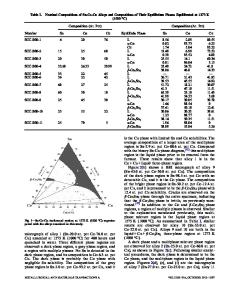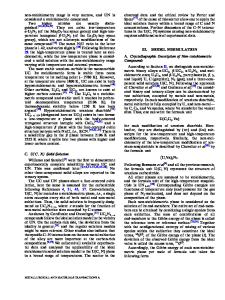Investigation of the phase equilibria at 773 K and metallic glass regions in the Ag-Al-Zr ternary system
- PDF / 777,320 Bytes
- 9 Pages / 612 x 792 pts (letter) Page_size
- 39 Downloads / 321 Views
Research Letter
Investigation of the phase equilibria at 773 K and metallic glass regions in the Ag–Al–Zr ternary system Hsien-Ming Hsiao, Department of Materials Science and Engineering, National Taiwan University of Science and Technology, Taipei 10672, Taiwan, Republic of China; Institute of Nuclear Energy Research, Taoyuan 32546, Taiwan, Republic of China Yung-Chin Lan, Gita Novian Hermana, Hao Chen, Department of Materials Science and Engineering, National Taiwan University of Science and Technology, Taipei 10672, Taiwan, Republic of China Yee-Wen Yen*, and *Address all correspondence to Yee-Wen Yen at [email protected] (Received 28 September 2017; accepted 8 December 2017)
Abstract Forty-eight different Ag–Al–Zr ternary alloys were prepared in various compositions to determine the metallic glass region in the Ag–Al–Zr ternary system. Experimental results indicated that the metallic glass region in the Ag–Al–Zr ternary system is Ag20–30Al10–30Zr50–60. The Ag20Al30Zr50 and Ag30Al20Zr50 alloys are supposed to have the best glass-forming ability in the Ag–Al–Zr ternary system. The phase equilibria of the Ag–Al–Zr ternary system at 773 K (500 °C) were investigated and compared with the metallic glass region results in the Ag–Al–Zr ternary system. Ternary isothermal sections of the Ag–Al–Zr system at 773 K (500 °C) were established and two ternary intermetallic phases were observed in this isothermal section.
Introduction Crystalline metallic materials are highly desirable in the industry because most of them have suitable thermal and controllable mechanical properties. Some metallic systems could be formed even in an amorphous state at an ultra-rapid solidification rate. Amorphous metals have been popular in recent years because of their unique properties such as high strength and excellent corrosion resistance.(1–4) The common metallic glass systems are Zr-, Cu-, Fe-, Ni-, and Mg-based alloy systems.(5) Owing to the recent technical improvements, it has become easier to produce bulk metallic glasses (BMGs) with high glass-forming ability (GFA) via inexpensive manufacturing processes. The GFA was a factor to evaluate possibilities of specific alloy systems to form BMGs, which forming chances could be determined by three empirical rules (proposed by Inoue(1,5)), Trg [reduced glass transition temperature(6,7)], Rc [critical cooling rate(1,5,8)], ΔTx [ = Tx − Tg, supercooled liquid region(1,5)], and γ [=Tx/(Tl + Tg)(7,9)], etc. Therefore, related BMG research has become more important. Zr-based alloys are suitable BMG candidates due to a broad supercooled liquid region and a high GFA in Zr-based alloys.(5) The elements, Ag and Al, are usually added to the Zr-based BMG systems to improve corrosion resistance, mechanical properties, and GFA.(10,11) Forty-eight Ag–Al–Zr ternary alloys were prepared in this study using the copper mold casting method to determine the metallic glass regions in the Ag– Al–Zr ternary system. Ag–Al,(12) Ag–Zr,(13) and Al–Zr(14) binary phase diagrams have been widely studied; however, on
Data Loading...











